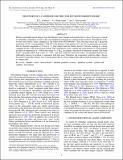| dc.contributor.author | Luhman, K. L. | |
| dc.contributor.author | Bochanski, John J. | |
| dc.contributor.author | Burgasser, Adam J. | |
| dc.date.accessioned | 2015-02-25T22:44:09Z | |
| dc.date.available | 2015-02-25T22:44:09Z | |
| dc.date.issued | 2011-02 | |
| dc.date.submitted | 2011-01 | |
| dc.identifier.issn | 2041-8205 | |
| dc.identifier.issn | 2041-8213 | |
| dc.identifier.uri | http://hdl.handle.net/1721.1/95646 | |
| dc.description.abstract | We have used multi-epoch images from the Infrared Array Camera on board the Spitzer Space Telescope to search for substellar companions to stars in the solar neighborhood based on common proper motions. Through this work, we have discovered a faint companion to the white dwarf WD 0806-661. The comoving source has a projected separation of 130'', corresponding to 2500 AU at the distance of the primary (19.2 pc). If it is physically associated, then its absolute magnitude at 4.5 μm is ~1 mag fainter than the faintest known T dwarfs, making it a strong candidate for the coolest known brown dwarf. The combination of M [subscript 4.5] and the age of the primary (1.5 Gyr) implies an effective temperature of ~300 K and a mass of ~7 M[subscript Jup] according to theoretical evolutionary models. The white dwarf's progenitor likely had a mass of ~2 M [subscript ☉], and thus could have been born with a circumstellar disk that was sufficiently massive to produce a companion with this mass. Therefore, the companion could be either a brown dwarf that formed like a binary star or a giant planet that was born within a disk and has been dynamically scattered to a larger orbit. | en_US |
| dc.description.sponsorship | Hellman Family Foundation | en_US |
| dc.language.iso | en_US | |
| dc.publisher | IOP Publishing | en_US |
| dc.relation.isversionof | http://dx.doi.org/10.1088/2041-8205/730/1/l9 | en_US |
| dc.rights | Article is made available in accordance with the publisher's policy and may be subject to US copyright law. Please refer to the publisher's site for terms of use. | en_US |
| dc.source | American Astronomical Society | en_US |
| dc.title | DISCOVERY OF A CANDIDATE FOR THE COOLEST KNOWN BROWN DWARF | en_US |
| dc.type | Article | en_US |
| dc.identifier.citation | Luhman, K. L., A. J. Burgasser, and J. J. Bochanski. “DISCOVERY OF A CANDIDATE FOR THE COOLEST KNOWN BROWN DWARF.” The Astrophysical Journal 730, no. 1 (February 25, 2011): L9. © 2011 The American Astronomical Society | en_US |
| dc.contributor.department | Massachusetts Institute of Technology. Department of Physics | en_US |
| dc.contributor.department | MIT Kavli Institute for Astrophysics and Space Research | en_US |
| dc.contributor.mitauthor | Burgasser, Adam J. | en_US |
| dc.relation.journal | Astrophysical Journal. Letters | en_US |
| dc.eprint.version | Final published version | en_US |
| dc.type.uri | http://purl.org/eprint/type/JournalArticle | en_US |
| eprint.status | http://purl.org/eprint/status/PeerReviewed | en_US |
| dspace.orderedauthors | Luhman, K. L.; Burgasser, A. J.; Bochanski, J. J. | en_US |
| mit.license | PUBLISHER_POLICY | en_US |
| mit.metadata.status | Complete | |
